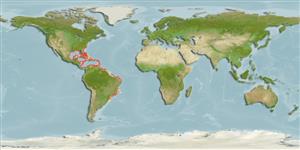Actinopterygii (ray-finned fishes) >
Perciformes (Perch-likes) >
Percophidae (Duckbills) > Bembropinae
Etymology: Bembrops: Greek, bembras, -ados = a kind of anchovy m+ Greek, ops = appearance (Ref. 45335); anatirostris: Specific name from the Latin 'anatinus' meaning duck's and rostrum meaning beak or snout, referring to its flattened duck-bill snout.. More on author: Ginsburg.
Environment / Climate / Range
Ecology
Marine; bathydemersal; depth range 100 - 400 m (Ref. 13628). Deep-water, preferred ?
Western Atlantic: northeastern Gulf of Mexico, Caribbean Sea off Puerto Rico, Surinam, and French Guiana.
Size / Weight / Age
Maturity: Lm ? range ? - ? cm
Max length : 35.0 cm TL male/unsexed; (Ref. 7251)
Generally found below 100 m to at least 400 m (Ref. 13628); enters shelf waters (Ref. 7251).
Life cycle and mating behavior
Maturity | Reproduction | Spawning | Eggs | Fecundity | Larvae
Das, M.K. and J.S. Nelson, 1996. Revision of the percophid genus Bembrops (Actinopterygii: Perciformes). Bull. Mar. Sci. 59(1):9-44. (Ref. 13203)
IUCN Red List Status (Ref. 115185)
CITES (Ref. 94142)
Not Evaluated
Threat to humans
Harmless
Human uses
More information
Common namesSynonymsMetabolismPredatorsEcotoxicologyReproductionMaturitySpawningFecundityEggsEgg development
ReferencesAquacultureAquaculture profileStrainsGeneticsAllele frequenciesHeritabilityDiseasesProcessingMass conversion
Tools
Special reports
Download XML
Internet sources
Estimates of some properties based on models
Phylogenetic diversity index (Ref.
82805): PD
50 = 0.5000 [Uniqueness, from 0.5 = low to 2.0 = high].
Bayesian length-weight: a=0.00389 (0.00160 - 0.00946), b=3.08 (2.87 - 3.29), in cm Total Length, based on LWR estimates for this (Sub)family-body shape (Ref.
93245).
Trophic Level (Ref.
69278): 4.2 ±0.5 se; Based on size and trophs of closest relatives
Resilience (Ref.
69278): Medium, minimum population doubling time 1.4 - 4.4 years (Preliminary K or Fecundity.).
Vulnerability (Ref.
59153): Moderate vulnerability (37 of 100) .
